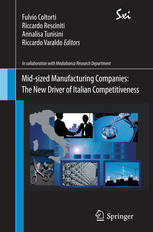

Most ebook files are in PDF format, so you can easily read them using various software such as Foxit Reader or directly on the Google Chrome browser.
Some ebook files are released by publishers in other formats such as .awz, .mobi, .epub, .fb2, etc. You may need to install specific software to read these formats on mobile/PC, such as Calibre.
Please read the tutorial at this link: https://ebookbell.com/faq
We offer FREE conversion to the popular formats you request; however, this may take some time. Therefore, right after payment, please email us, and we will try to provide the service as quickly as possible.
For some exceptional file formats or broken links (if any), please refrain from opening any disputes. Instead, email us first, and we will try to assist within a maximum of 6 hours.
EbookBell Team

4.3
68 reviewsThe structure of Italian industry is characterized by a predominance of small sized companies and the presence of very few large companies. For a long time a conviction was shared among scholars and practitioners that the strength and safety of Italian industry were based on its industrial districts, that is, the system of interdependent and co-localized small companies which derive their competitive force from an effective and efficient division of labour. This book stresses the idea that a new, vital and promising phenomenon for the competitiveness of Italian industry is focused on mid-sized companies, and the systems of interconnected firms that form a constituent part of their business model. These companies, which originate largely from districts and other local production systems, are a strong entrepreneurial force complementing the districts that have characterized Italy and made Italian industry famous worldwide. A quantitative and qualitative analysis of these firms is provided in this book. Business models and strategies implemented by a number of successful Italian mid-sized manufacturing companies are also explored. Consequences in terms of management and industrial policies are provided. A final look at the German Mittelstand gives a useful comparison.